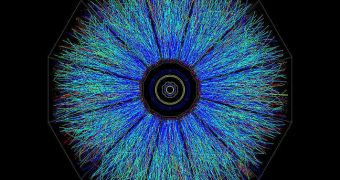For a long time, astrophysicists have been puzzled by the reason why matter prevailed over antimatter, just seconds after the Big Bang exploded everything into being. According to theory, everything currently in the Cosmos should not have existed. The initial explosion should have produced equal quantities of matter and antimatter, which should have canceled each other out. As it stands, matter prevailed, and physicists now believe they may know why. The study that led to this conclusion was conducted at the Relativistic Heavy Ion Collider (RHIC), at the US Department of Energy's (DOE) Brookhaven National Laboratory in Upton, New York, Nature News reports.
Experts say that the jumble of melted protons and neutrons that forms when two particles are collided in the RHIC is the hottest fireball on the planet. Recently, scientists have been able to measure the temperature inside, and have found it to be reaching around four trillion degrees. It is made up of a “soup” of subatomic particles that also exhibits tiny bubbles. Physicists believe that these bubbles are the key towards understanding how matter prevailed over antimatter in the early moments of the Universe, and therefore allowed for stars, galaxies, black holes, planets and life to develop.
“This asymmetry is crucial to our existence,” Brookhaven theorist Dmitri Kharzeev explains. He proposed more than 12 years ago that these bubbles existed, and it's only now that scientific experiments have managed to prove him right. The results of the new investigation were presented at the February 15 meeting of the American Physical Society, in Washington DC. Experts at the RHIC have been conducting analyses of the elementary particles that form following collisions between gold nuclei for a long time, but, five years ago, they announced that they were beginning to make sense of their own observations.
While considerably smaller than the Large Hadron Collider, the RHIC is still massive, featuring a ring about four kilometers wide. The accelerator conducts experiments at a total energy output of 200 gigaelectronvolts (GeV), as opposed to the LHC's top energy level of 14 teraelectronvolts (TeV). As gold nuclei are smashed together, they break apart into the hadrons that make them up. These include protons and neutrons, which are further made up of gluons and quarks. These elementary particles are very tightly bound to each other. When the nuclei collide, the immediate result is the formation of “quark-gluon plasma,” which is incredibly hot.

 14 DAY TRIAL //
14 DAY TRIAL //